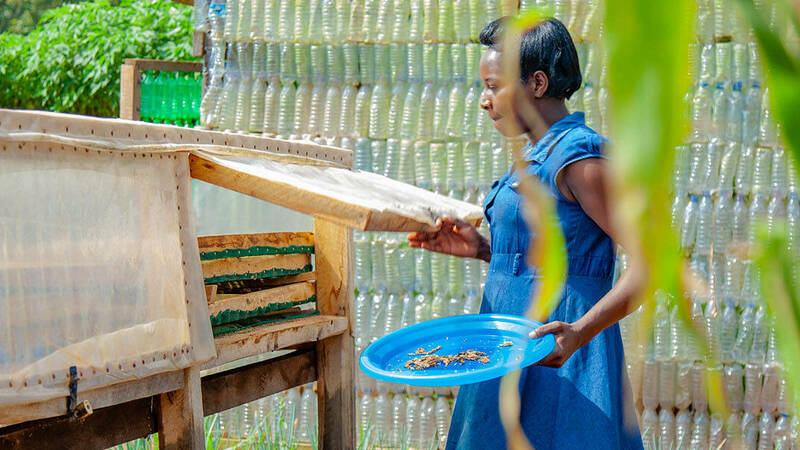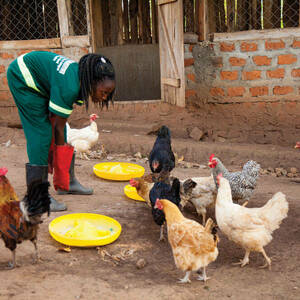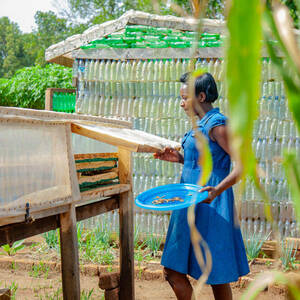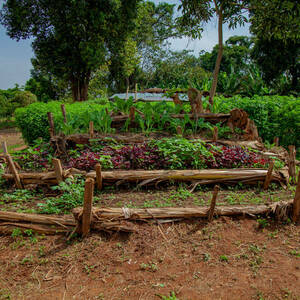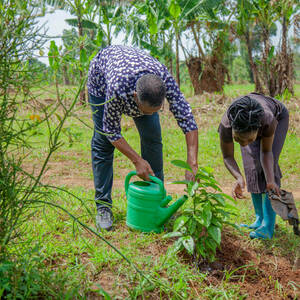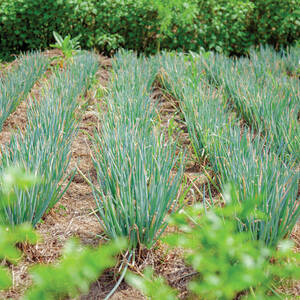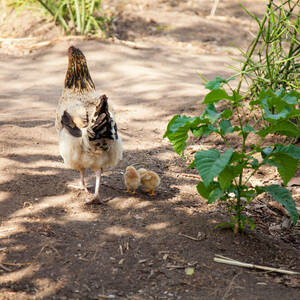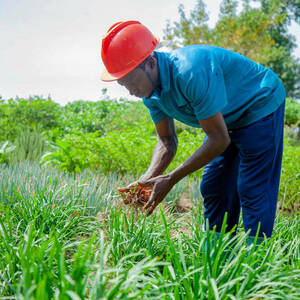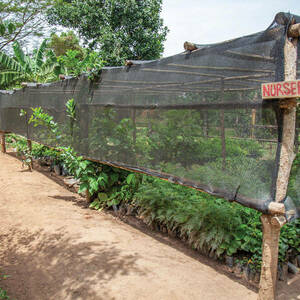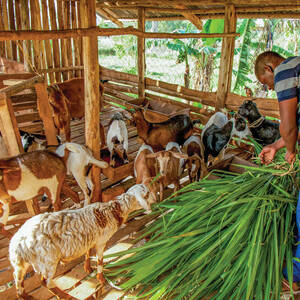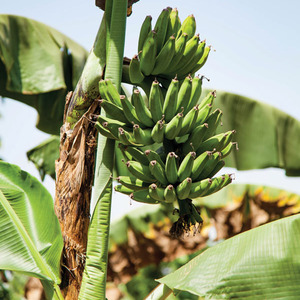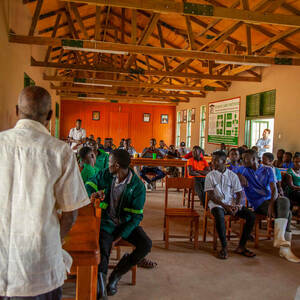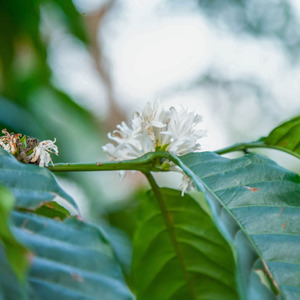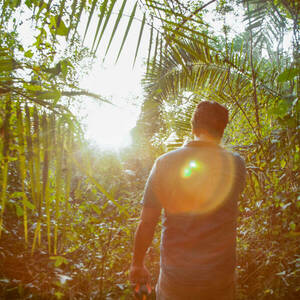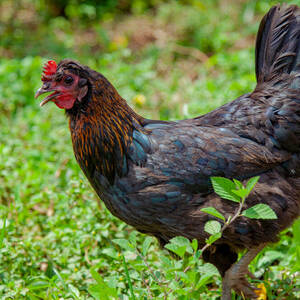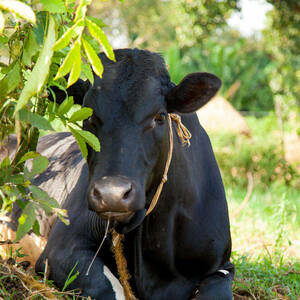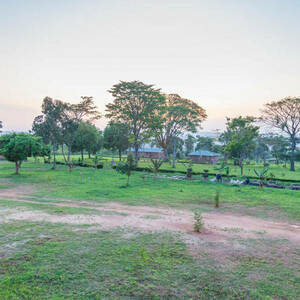Alice Joyce Nanfuka, five feet and a few inches of courage, hope and raw determination, stands on the hard earth outside her rural Uganda home in green coveralls and turquoise Wellingtons. She greets our vanload of visitors as we fan out across her dusty front yard.
If she is intimidated, she isn’t showing it. She will tell us her story today.
She’ll save the part about her father leaving her mother to raise Alice and her four siblings alone in that tiny brick house for the questions and answers. Same goes for her conversion, the vital lesson she learned from a square of land, that moment when she abandoned youthful dreams of effortless consumption and comfort and got excited about her life.
Instead, Alice, age 20, a smiling embodiment of modest serenity, begins by showing these nine serious men, most of whom are much older than she is, what she sees happening here on NAJ Integrated Farm — “nadj,” she says gently, “N.A.J.,” her initials in their Ugandan order.
She begins with her vision.
She has no money, “no supporters.” Not yet. She needs worms. She needs water, more than she can yet gather in her two small barrels and their corrugated tin catchments, even in March with the spring rains expected to start any day. She is making compost to repair the soil. She has plans for chickens, for pigs. In five years, a cow.
Alice’s vision begins with spring onions because that is what she has. Their green shoots rise from dry, thatched beds framed by the stones and bricks she has collected from the property, a spray of vibrant color on the tan soil that bakes beneath the powerful equatorial sun. These onions are step one of her horticulture project.
Alice the farmer pauses, shakes her head, looks at the ground, her smile sparkling. She says, “I’m having very, very many things in my head.”
She mentions cucumbers — and a plan to make cucumber juice that she will serve one day from a refrigerator to visitors in her farm store. She mentions nakati, grown for its greens and, in some varieties, for its eggplant-like fruit, which leads to talk of a nursery that will sell seeds and sprouts to neighboring farmers. She explains her conspicuous mountain of plastic bottles, and how she’ll mix them one day with sand and turn them with a spade in a giant saucepan. Thus will she make pavers more durable than the costly, mass-produced, concrete kind. She will sell some and use the rest, so her customers will have a tidy place to park.
Across the road, schoolboys play soccer in green and blue pinnies. Two children amble by with firewood bundles balanced atop their heads. Alice speaks of friends from school who got married and live nearby. Some already carry children on their backs. They do not look at Alice or her plastic bottles as they walk past her farm. Other friends, the ones who attend university, wonder why she chose agriculture. They smile at her organic methods, her new ideals. She tells them to come back in a year. “Why I tell them one year?” she says, her voice full of cheerful defiance. “Because I know in one year I’m going to be somewhere.”
Alice leads us to the pigsty she will borrow from her mother. The back of her coveralls reads “Bethany Land Institute — Forming Leaders in Integral Ecology for Rural Transformation.” BLI is Alice’s alma mater, where in 2022 she and seven fellow students became the first cohort to complete their training. It’s the place that planted all these ideas — these seedlings of zero-waste permaculture, Catholic social teaching and a better tomorrow for Africa — in her head.
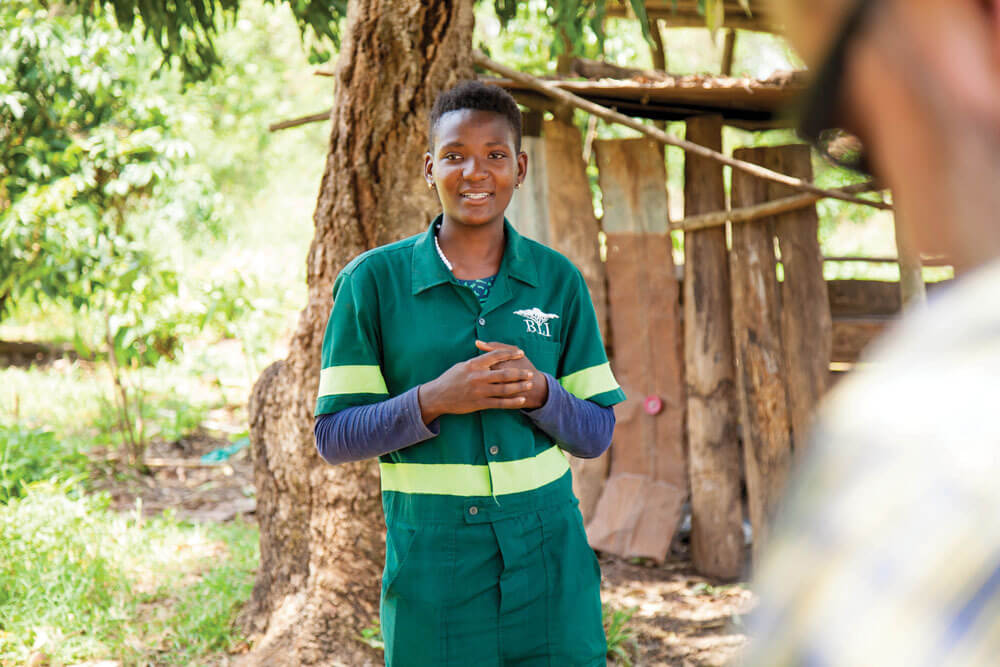
A few miles southeast of Alice’s farm, Bethany Land Institute sits on 367 acres — more than half a square mile — of neatly ordered demonstration gardens, rolling open land and recuperating forest in the central Ugandan village of Nandere. Founded in 2015 at another site, it has evolved in concept, moved location and reopened its doors in 2021 as a school of spiritual formation and leadership training, a nursery for a new generation of farmers who will transplant themselves over time into every corner of Uganda’s badly abused yet green and pleasant landscape.
This is the heart of the Luweero Triangle, “once an epicenter of harsh conflict and violence,” explains Father Emmanuel Katongole as we turn off the freshly asphalted highway that bisects the country and connects its two largest cities — Kampala, the sprawling capital, an hour and a half to the south, and Gulu, far to the north.
During the Ugandan Bush War of the 1980s, as the country struggled to gain its footing after the barbaric dictatorship of Idi Amin, “the rebels would hide in the forests and attack government vehicles,” Katongole says. To retaliate, “the government would kill everything. Everything living. Dogs and other animals. Banana trees.” Just to scare people out of helping the rebels.
Thousands were recruited to fight for one side or the other; thousands more were killed in the crossfire. Towering old-growth forests that once defined this landscape were felled or burned.
Forces led by Yoweri Museveni, Uganda’s president since 1986, won, but reconstruction in Luweero and surrounding districts never matched survivors’ hopes. Nearly 40 years later, Katongole says, people here still feel “used and left out.”
At the time of the cease fire, Katongole, now the president of BLI, was 25 years old and studying to become a priest of the Archdiocese of Kampala. He spent those first, relatively stable years after Museveni’s victory and his own ordination serving in a parish and training seminarians, then left Uganda to study philosophy at the Catholic University of Louvain in Belgium. And although he’s lived most of his adult life in the United States, landing at Notre Dame as a professor of theology and peace studies in 2013 — getting involved in parish work in every city along the way — his heart has never left Africa. Wherever he goes in the world, there’s a three-acre farm in Malube, a village so blessedly small that Google Maps doesn’t know where it is, where Katongole in a visceral way feels “grounded.” It is his taka, his soil.
That’s where he was born in November 1960, the fifth of seven children whose parents had emigrated from Rwanda in the 1940s. His mother, Madalena Nyinaruhango, was the daughter of a Hutu chief who would be the one to name him “Katongole,” or “Little Chief”; his father, Antonio Bukerimanza, was a poor Tutsi laborer. Together the family raised, “like many African homesteads,” he says, “a bit of everything”: goats, pigs and chickens, a rich variety of fruit trees, the matoke bananas that form the central staple of family meals, and a nearly endless list of organic abundance: pumpkins, coffee, sugarcane, cassava, ground nuts, beans, sweet potatoes, yams, green peppers and other garden vegetables.
“Every morning we would wake up — 5:30 — and go work in the garden,” Katongole remembers. “And then run to the stream, get water, come, wash quickly, and then we walked two miles to the school. Every evening also, we’d do the same.
“Working with the soil: It kind of cultivated me, from early on, when I was a kid, every morning, connecting with this piece of land.”
Something else connects him to this small patch of Earth, makes it butaka, his connection to a web of belonging: the burial of his umbilical cord on his family’s land, a common postpartum ritual throughout much of Uganda and other African countries. “Within African cosmology,” the Catholic theologian explains, “whoever is living is connected to the world of the ancestors, those who have gone before. That’s where meaning comes from — a deep connection with the land, with the soil.”
Katongole’s father died in 1972 when the boy was 11. His mother tilled and kept the land for another 47 years before she died at age 93. Their bodies are buried in a tree-encircled plot on the farm alongside two of Katongole’s brothers and other relatives, and the farm remains in the family.
In 1994, another explosion of violence carved its mark on the priest, as it did for all Africans and much of the world: the 100-day Rwandan genocide, in which more than a half million Tutsis and others were murdered by Hutu militias armed with machetes and machine guns. Hearing the news at Louvain, a fellow doctoral student from Asia asked Katongole, “Why do you Africans kill your own people?” The assumptions behind the question were offensive, infuriating. The pain seared to the core of his attachments to his family and its history.
Just as painful was contemplating how Christians could kill Christians so pitilessly. The slaughter had begun during Easter week, days after many killers and their victims had worshiped together in the same churches.
Such matters wounded and haunted the young scholar, shaping much of his work over the next three decades in 11 books and numerous articles on faith, reconciliation, theology, politics, identity and the future of his continent, a scholarly output that in 2018 landed him among the “fifty minds that matter” — Catholics who change how we understand the world — compiled by the London-based Catholic weekly The Tablet. The list included both living popes at the time, filmmakers Terrence Malick and Martin Scorsese, philosophers Alasdair MacIntyre and Charles Taylor, novelist Toni Morrison, Bruce Springsteen and Katongole, whose book, The Sacrifice of Africa, was praised as “a masterpiece in reimagining” African history, politics and religion.
All along, he has concerned himself with healing Africa as much as diagnosing its ailments. In 2015, Laudato Si’, Pope Francis’ encyclical letter “on care for our common home,” infused his work with new concepts. But its animating fire came from the sound of chainsaws Katongole heard whenever he returned to Malube. The tentacles of Uganda’s unrelenting deforestation — more than half its forest cover has disappeared since 1980 — had lain hold of his neighbors’ trees for firewood, charcoal, brick kilns and the clearing of land for nonnative tree plantations that could predictably and profitably be measured in board-feet and Ugandan shillings. Whole marshes disappeared into thirsty pine and eucalyptus taproots, and soon the stream where the internationally renowned theologian drew water as a boy was little more than a turbid puddle.
The Ugandan government calls this “the scientific management of trees,” he notes ruefully.
Alice Nanfuka’s onions grow today in a small bed near a dirt road in Nakaseke, but they took root 11 years ago in the rich, dark soil of Father Emmanuel Katongole’s righteous anger.
Sylvester Kule remembers a day in the summer of 2020 when he didn’t see or hear a single bird on the BLI campus. The school had yet to open, but work had begun to build livestock enclosures, to lay out gardens, to remove the swaths of polyethylene sheeting used by former tenants for shortcut weed control, to plant trees by the thousands.
Good-neighbor diplomacy was already part of the school’s job: conversations in the village to explain that this farmland and forest owned by the Diocese of Kasana-Luweero and leased to the school was now off-limits to the local customs of tree-cutting and windfall firewood harvesting — though the latter would be permitted biweekly on designated days. Dialogue with the priests up the hill at Our Lady of Grace, one of Uganda’s oldest parishes, and with the minor seminary and nearby Catholic schools addressed land use habits. They discussed the overuse of herbicides and fertilizers in the parish banana grove and whether the priests might consider harvesting their eucalyptus trees and selling that plot to BLI ahead of schedule.
Such conversations continue. Kule, the agroecologist invited to become the school’s founding programs director, put what’s become his students’ mantra into practice right away: Start small. Start smart. Start now.
Already, he says, animals are returning. More than 200 species of birds — like the troop of great blue turacos swooping into the trees overhead with comic fluidity. Three kinds of primates and at least one of antelope. Foxes. Bees. Snakes: an ambivalent development to the untutored guest perhaps, but to BLI faculty and their students, called “caretaker trainees,” they’re another vital sign of a Ugandan forest being restored to health.
Chris Mukwaya, the head forester, says BLI students, staff, neighbors and visitors have already planted more than 125,000 trees toward the school’s goal of 1 million by 2050. And they have reintroduced several “extinct” — locally, anyway — native species: the mugavu, whose bark may be used to treat bleeding and dysentery and whose leaves make bananas ripen faster; the umbrella tree, a fast-growing marvel of reforestation especially salutary for the shade it provides to coffee and cacao trees; the African cherry, an invaluable food source for forest birds and mammals; the African teak, a carbon sponge and erosion stopper known also for its medicinal properties and its gorgeous, termite-resistant hardwood.
By summer 2022, as the school prepared to commission its first class of caretakers and to host an academic delegation from Notre Dame, the archbishop of Kampala, the prime minister of Uganda and other officials, every one of whom planted a tree, BLI’s “Lazarus” forest required no explanation of its name. The dying forest had come back to life. Within months, its stream would begin flowing again for the first time in local memory.
“We have given it its freedom,” the jovial Kule says of the forest and this first-stage BLI achievement. “The soil is happy now.”
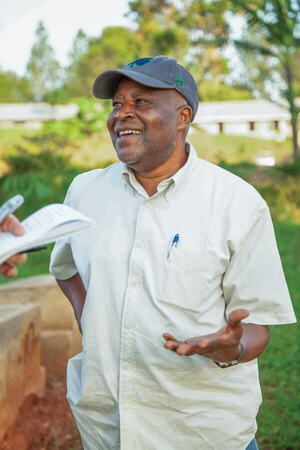
Lazarus’ Trees, Mary’s School and Martha’s Market are the three core components of Bethany Land Institute that help explain the school’s name.
“When I think about Christianity, its gifts, possibilities, and challenges on the African continent, the name Bethany immediately comes to mind,” Katongole writes in Stories from Bethany, a book of meditations upon several key moments in the gospels. Bethany was the home of the three siblings in whose cottage near Jerusalem Jesus stayed whenever his mission led him — reluctantly — to that city. It was, Katongole explains, a place of respite and hospitality for the poor and the marginalized. Lepers lived there. But it was also a place of “interruption,” of lived resistance to the civil and religious mindset and power concentrated in the city at that time.
The application to the political, economic and technocratic troubles of our own century may be obvious. But Christianity, too, needs interrupting, Katongole argues. Are Africa and the rest of the global south beacons of hope to a Church dying in Europe and North America? “While there is no doubt about the growth of Christianity in Africa, which is a source of great confidence to African Christians,” he writes, “the realities of poverty, war, violence, political instability and tribalism are also . . . prevalent on the continent.” If the future of the Church lies in Africa, Katongole wonders “what kind of future this might be.”
As always, the specter of Rwanda, 1994, looms in his mind, representing the danger of lurking flashpoints left unaddressed. Bethany is the antidote; each sibling an inspiring metaphor for African renewal. Lazarus, whom Jesus loved, could hope for resurrection even as he faced illness and death. Mary, who always sat at Jesus’ feet even while her sister hustled to serve him, shared a “delightful intimacy” of mutual listening with her Lord and learned how to set priorities based not on relevance or humanitarian urgency but rather on “the odd, excessive logic of self-sacrificing love.” And Martha, who boldly welcomed this man Jesus into her house, who was the only one of his disciples other than Peter to declare belief in him as “the Christ, the Son of God,” modeled humility, hard work, generosity and leadership.
Published in 2012, Stories from Bethany conveys more hope than anger. And even as he wrote, Katongole was channeling the latter emotion into an idea: He would celebrate the 25th anniversary of his ordination by buying land.
His neighbors in Malube might clear their forests out of desperation, ignorance, shortsighted greed or some combination of such things, and that battle was lost. But Katongole could plant another forest. He wanted 10 acres. He asked around. He told a friend from his seminary days, thinking he might know someone with land to sell.
In fact, Father Cornelius Ssempala had just bought some land himself, thinking he would start a new kind of school.
‘We are not freedom fighters. We are really saying that there is something that went wrong at the foundation of this modernization here. But now, how to synthesize, that’s the African issue.’
Uganda is a young country. Seventy percent of its citizens are 25 or younger. Decades of postcolonial war and the HIV/AIDS crisis that peaked in 2001 have decimated older generations, but the “Pearl of Africa” also has one of the highest birth rates in the world.
One consequence of this demographic extremity is severe un- and underemployment. The U.S. State Department reports the Ugandan government’s official jobless rate of 9.4 percent but notes this isn’t “the real picture.” Conventional farm labor, by far the largest jobs sector, suffers from limited hours and low wages. Katongole, who has interviewed young Ugandans living in Kampala’s rapidly growing slums, multiplies the official figure by 10. Even for college graduates, full-time, salaried work is rare, benefits almost unheard of. Most buy a motorbike and hustle and maybe clear 10,000 shillings a day. That’s about $3.
Most of these young slum-dwellers consider themselves “visitors” in the city, yet they insist that to go back where they were born would be to fail. They’ve accepted the modern, Western notion of the village as backward and the city as forward. By reinforcing this idea, Katongole writes, African educators, politicians and business leaders create the very poverty and hopelessness they pin on the village. Most of the continent’s projected population growth of 1.1 billion people over the next 25 years is expected to happen in slums. And yet: Every person Katongole interviewed said they want to “return home” when they die — to be buried on their ancestral land.
“It is a generation that has no direction,” says Father Ssempala, a farmer and professor of philosophy and education at Makerere University in Kampala. “Energetic, very bright, but rendered useless” by their lack of access to education and well-paying, meaningful work.
The education on offer is itself a problem, he says. At his own institution, older colleagues were teaching the same curriculum handed down from the British colonial system. Innovations took cues from market-driven priorities and metrics that came from everywhere but Africa.
“The problem was starting from nowhere,” he argues. “A point of view from nowhere. A universal curriculum.”
And an education should be?
“Rooted,” he says. “Continuous with the experience of the village. Continuous with the language of this child. . . . And then that education is meaningful.”
A third friend from seminary, Father Anthony Rweza ’98MSA, joined the brainstorm on the germinating farm-and-school project, adding economic wisdom to the insights on education and ecology. Rweza, who died in 2021 from COVID-19, reminded Katongole and Ssempala that young Ugandans were draining wetlands, burning bricks and flocking to Kampala for a reason. “They need skills, they need to feed their families,” Katongole remembers BLI’s third co-founder saying. “They’ll cut down your trees unless you have an economic aspect to this.” Rweza’s ideas begat plans at BLI for a roadside market and a cooperative savings and loan to help students grow their money as they grow their matoke.
Laudato Si’ infused the priests’ vision with inspirational lightning. The pope persuasively articulated “the cry of the earth and the cry of the poor” from a platform and with a power that no other writing on the environment and the global economy had achieved. The ecological problems of “our common home” are at core a spiritual problem, he argued. An “integral ecology,” modeled on the spirituality of St. Francis of Assisi, would tie these crises together with care for the poor and take us to “the heart of what it is to be human.”
Fragmented technological approaches to climate change and other woes would not suffice, Francis wrote:
There needs to be a distinctive way of looking at things, a way of thinking, policies, an educational program, a lifestyle and a spirituality which together generate resistance to the assault of the technocratic paradigm. Otherwise, even the best ecological initiatives can find themselves caught up in the same globalized logic.
If the world needed a model of integral ecology, Katongole thought, why not in Uganda? BLI could become a living laboratory of Laudato Si’.
Trouble came quickly. A lawsuit disputed their ownership of their land, acquainting the men with Uganda’s colossally flawed land laws.
But another friend, the bishop of Kasana-Luweero, saw Francis’ writings and the Bethany project as a “godsend.” He offered them far more acreage for cultivation than BLI had before, plus an endangered forest — the last one for 125 miles on the drive toward western Uganda’s safari parks.
Bishop Paul Ssemogerere did more. During the coronavirus lockdown of 2020, he sent his 14 seminarians to BLI to learn integral ecology rather than let them idle, establishing a precedent for the diocese’s priests-in-formation. Now, as archbishop of Kampala, he is BLI’s leading ecclesiastical champion. The Italian bishops and a community of Franciscan nuns pitched in, too, funding dormitories to house 16 young men and 16 young women, a classroom building and staff houses.
Awaiting a new bishop, the diocese’s administrator, Monsignor Francis Xavier Mpanga, is working with BLI on plans to train his 466 catechists — the lay men and women who staff the dozen-plus chapels attached to each of the diocese’s 20 rural parishes — in integral ecology. Already, he says, each parish has planted a “Laudato Si’ forest.”
At BLI on a sunny Tuesday in early March, teachers lead a tour of Mary’s Farm, which will eventually cover another 100 acres. “We go deep into the ethics of agriculture,” says Mike Segalunyo, who attended agriculture college before coming to BLI, where he teaches animal husbandry. In college, he learned how to use chemical antibiotics to raise animals and chemical pesticides and fertilizers to plant large fields of genetically modified crops with predictable yields. Soil health, the value of indigenous seeds, how to save money by “mimicking nature” were not on the curriculum.
He explains the elevated goat shelter that he designed and built on a sloped concrete pad because goats like to climb and the pad captures dung and urine without need for constant cleaning. He teaches students how to make their own structures and fences so they can get started without borrowing to buy expensive, manufactured products.
The goats’ large pen is full of greenery — horse beans, for instance, which goats won’t nibble but which, when dried, roasted and ground to powder, become an ideal protein source for poultry. The chickens, meanwhile, ignore the elephant grass in their pen, but the tall, fibrous plant is a valuable cattle and goat fodder — and the guinea hens like it for egg-laying because it makes them feel protected.
The farm does not smell like, well, a farm. Fresh breezes blow in from Lazarus Forest. Ivan Bukenya explains how moringa and other native botanicals provide nutrition and natural livestock antibiotics; how to use red pepper, garlic, marigolds and other plants to brew sprays that repel crop pests without killing “our brothers and sisters” in the ecosystem. Jonathan Makubuya presents the maggot house and fishpond — vital components of the animal feed program. Harriet Mercy Alum introduces the seed-multiplication garden, where indigenous varieties nearly lost in favor of genetically modified monoculture are being restored. Luweero District is home to at least 19 varieties of banana alone.
“In Africa, we live with plenty, but we have not been able to manage the plenty we have,” says Sylvester Kule, the headmaster. However well-intentioned, the West’s so-called Green Revolution maximized yields in the name of efficiently addressing famine and hunger, as if hunger were a problem of the land and not of government policies, markets and distribution. But Kule argues that its tools and technologies expanded the problems they were supposed to solve, serving corporate agribusiness profit margins while clearing forests and compromising soil health at the expense of the poor smallholders who couldn’t afford the inputs required to keep up. Many were forced to abandon the land.
Damascus Ochieng, a 23-year-old student, finished high school and a conventional family certificate program in agriculture before arriving at BLI. He says he didn’t know it before he came, but “what I wanted was here.” He wants to open “something like BLI” in his eastern village, where people his age might discover a passion for organic agriculture. Adapting what he’s learned to his semiarid part of Uganda will be difficult, he admits. But he knows his peers. “When they see another youth doing something, they believe it is possible.”
“We are not freedom fighters,” Ssempala says, laughing. “We are really saying that there is something that went wrong at the foundation of this modernization here.” At BLI, he adds, students learn the global outlook and understand the science of what they’re doing — and not doing. “But now, how to synthesize, that’s the African issue. Don’t be passive recipients of global knowledge!” he cries, his voice rising. “That’s dangerous. That’s why we are passive recipients of aid. Passive recipients of everything. As if we can’t do anything.”
They call farm work “digging” in Uganda, and few young people grow up wanting to do it. Maybe that’s because digging now is typically a high-risk, high-stress, low-reward scrape and not an enriching way of life as it was when Father Katongole was a child. Mike Segalunyo never felt this childhood aversion, but he understands it. “It’s like a punishment,” he says. “If you do something wrong, you go in the garden.”
Alice Nanfuka has earned the green coveralls she wears at NAJ Integrated Farm. She is a graduate of Bethany Land Institute, a leader in integral ecology. But growing up, she and her younger sister Immy Nambirige didn’t want to dig.
After high school, Alice left for Kampala to sell rice and posho in her aunt’s shop. On visits home, she’d wake up at 9 a.m., long after sunrise. Maybe earlier when it was her turn to fetch water for the day.
Her uncle told Alice’s mother about BLI. Alice wanted to make money, not to go back to school, but her mother talked her into trying it out. Alice didn’t like it. She could see they weren’t spraying chemicals, that the plants were healthy and “shining,” that BLI was teaching something different. That wasn’t enough.
The headmaster urged her to stay and assured her the school wouldn’t chase her mother to pay her fees. Still, Alice wasn’t sold.
One day, “they gave me a plot. It was 10 by 10 meters,” she says. “I put in my nakati. I got a lot of money. I only put in 10,000 [shillings]; I got 100,000.
“Then I said, ‘I’m not going anywhere.’” She laughs.
At BLI they call this conversion “mindset change.” Sometimes they’re talking about creation care. Sometimes they’re talking about clearing a path out of poverty, a satisfying, sustainable way of living on Earth while making a living.
Usually they mean both. To date, Alice has recruited Immy and three friends to the school. Each was as skeptical as Alice once was. “You come and see,” she told them. And they did.
Alice and her siblings never hear from their father. Their mother has “given” Alice the land around their childhood home for five years. She owns another small plot some miles away and walks there every morning to cultivate it. Alice’s younger siblings stick around and help Alice when they’re home from school.
When she graduates from BLI and receives her commission, Immy will join her sister to raise the pigs and chickens. One day, they plan to buy their own farms and return the land they’ve improved to their mother. Immy will start with pigs, she says, a sweet lilt in her voice, because “I like pigs from the bottom of my heart.”
“Integral ecology was my best plan,” Alice says, looking back. “There were very many lessons which made me happy.”
And now? “From the first waking up, I actually have a plan for the next day. . . . I am thinking and looking around, like, today, what can I start with? I wake up, and I have everything in my mind.”
Tomorrow morning, March 9, 2023, Alice Joyce Nanfuka will rise with sun. She will keep digging. And she will wait for the rain.
John Nagy is managing editor of this magazine.
